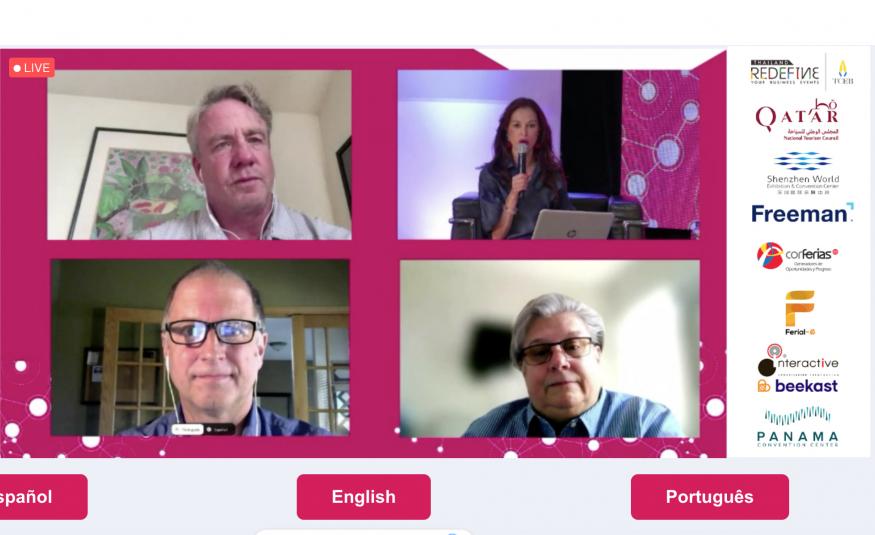Global trade association of the exhibition industry, UFI’s Latam (Latin America) Conference is underway, 10-12 August.
Open to both UFI members and non-members, the digital-only conference is gathering industry leaders from the region to discuss common strategies for different realities in Latin America and beyond.
Day 1 opened up with sessions on, ‘Envisioning the future of the exhibition industry in Latam’ and ‘Venues: Reinvention, challenges, strategies’.
A final session of the day on ‘The exhibitor transition and the change in their expectations’ featured Hewlett Packard global event manager Glenda Brungardt, CEO of MAD Event Management Marty Glynn and president and COO of Exhibitor Media Randal Acker.
Brungardt gave some powerful corporate insights as she explained HP did not expect to be looking at returning to events business as normal. “Our budgets have changed. The bottom line is we cannot look to having an increase in our budget to see fewer attendees. We need to look at cost savings across the show floor. It’s harder to justify our spend against everything else we’ve been doing for the last 18 months. Traditional sponsorships need to change. We need real engagement opportunities to connect buyers and sellers… We’re also seeing challenges with the workforce. And, as exhibitors, we are as concerned as the organisers as to what the future workforce looks like.” She added that health and safety would be another issue at the forefront moving forward and provides more food for thought about what goes into the HP events budget in future.
Brungardt added that she would be looking for value across the board. “We’re looking at alternative venues, ones that provide better internet. That is extremely important. We’re looking at venues with a broadcast studio.” And she added that any future event strategy would need to be backed up by data. “It is no longer just buying space, but we’re buying access to data, which allows me to make an informed decision moving forward. We need more than just the number of people attending.” Questions such as how visitors interacted with the brand were paramount, she added.
Randal Acker noted the absence of face to face marketing had had a big effect and quoted several statistics from recent research among event professionals in the Americas. “Even though they have adopted other channels, 45% say they have extreme lack of leads and sales opportunities,” he said, adding that 34% said they were now unable to increase and build brand awareness. “Twenty-three percent of those polled say they struggle to launch new products during the pandemic,” Acker noted, while 21% were still looking to cut budgets. Fifty-two percent said they we would participate in fewer shows. And 41% will bring small exhibits, he added.
Marty Glynn said he and his panelists had discussed the shape of things to come often and came to the conclusion that there was “nothing profound” to be said. “It all comes down to communication.” He thought the pandemic had highlighted a problem that “everybody stopped listening to each other, with exhibitors and their problems often getting tuned out by organisers. It can’t happen anymore, particularly as 52% say they are not coming back to events in the same way.” Glynn said it was a serious situation that required a new focus on the exhibitor and on properly onboarding new exhibitors on how to maximise their value and time at a show. “Organisers need to get into a granular position to understand what the exhibitor problem is. You need to hear it and live it. For so long it hasn’t been done. Exhibitors now know all about data and what’s up. We need to right some wrongs.”
Brungardt said the main takeaway for organisers from the session should be: “Really ask yourself what can I do differently, to look at the exhibitor differently as a customer to come back. What part of the existing model can you change?”
Audience questions to the panelists included how to ensure return on investment from a hybrid fair.
The consensus seemed to be that it came down to objectives and what you’re looking to measure. Brungardt said: “We track data during shows so sometimes know immediately.” And she said that ROI was not only regarding sales, but also about moving brand image and educating.” She was still somewhat vague about measuring the results and said the follow up conclusions on strategy could take up to a year.
Ana-Maria Arango, UFI regional director for Latin America, facilitated the first day’s content from Bogota, which included a quiz element at the end, and all sessions that were in Spanish, had both a Portuguese and English translation available.
The conference continues 11-12 August and opens at 9am Bogota Time. To register and for more information, visit here.





